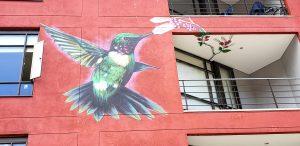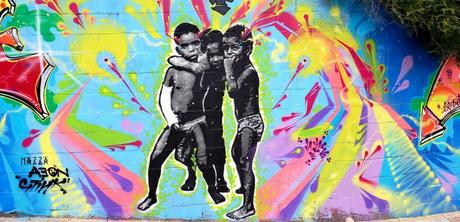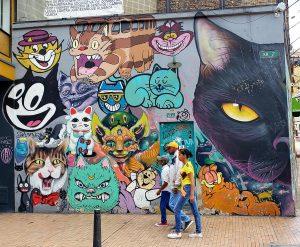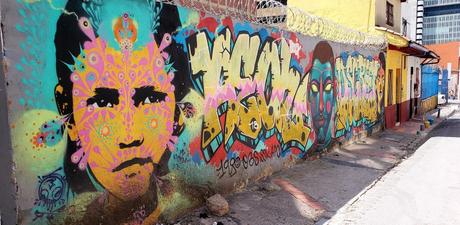 "See that hummingbird? They appear frequently in murals because we have over 100 different types of them here in Colombia," says Jay, my tour guide. Bogota would probably not come to most people's minds right away when thinking of the world's great street art traditions. Yet, here I am, standing in the middle of the colorful La Candelaria district, surrounded by mural-covered walls everywhere I look. It is a veritable 360-degree immersive graffiti experience. "Once you paint a neighborhood, it is like it is reborn," notes Jay. "The neighbors come out and talk to each other in a way they never did before."
"See that hummingbird? They appear frequently in murals because we have over 100 different types of them here in Colombia," says Jay, my tour guide. Bogota would probably not come to most people's minds right away when thinking of the world's great street art traditions. Yet, here I am, standing in the middle of the colorful La Candelaria district, surrounded by mural-covered walls everywhere I look. It is a veritable 360-degree immersive graffiti experience. "Once you paint a neighborhood, it is like it is reborn," notes Jay. "The neighbors come out and talk to each other in a way they never did before."
As we walk the streets and passages of the city, he points out select artists and shares some background about their varying styles. Bogota is a thriving cultural hotbed of street art. New artists seemingly pop every day. By the latest count, there are over 8,000 of them - and growing. Many international graffiti artists have also made their way to Bogota in recent times to join what is one of the trendiest cities in the world for urban art.

The city has a complex love-hate relationship with street art - alternate city governments have passed laws either outlawing graffiti or subsidizing it. The result is a convoluted tug-of-war between various graffiti collectives and government agencies. Previous mayors saw street art culture as an important tourist draw and actively encouraged it. No more. The current Mayor of Bogota has all but declared war against what he considers the hideous eyesore ruining the city. Underlining the ambiguous feeling is the reaction of the police - sometimes they look the other way, sometimes they enforce the law.

Even today, it is impossible to separate street art and politics. In Colombia, the two are intractably intertwined - you can't have one without the other. Along the walk, Jay loves to highlight murals that capture Colombia's complex social struggles - the plight of indigenous tribes, tensions among the modern political left and right, the horrors of the drug war, or the still sore legacy of colonial and imperial interventions. Even though the truths depicted here are not always pleasant, Jay takes obvious pride in educating his audience.

Jay himself has a colorful background. Fluent in both Spanish and English, he was born in Bogota and grew up in New York. His affable smile, local knowledge and patient conversational style make him the perfect tour guide. His love for street art is apparent in his passionate descriptions of both the art as well as the personalities and politics behind each piece.

Perhaps the biggest source of friction is the city's effort to safeguard the colonial-era buildings of the Candelaria district, he explains. No longer the violent, drug-ridden country of the 1990s, international tourism is finally sprouting in Colombia, providing a much-needed revenue boost for the economy. Bogota's city government hopes to encourage this by preserving the historic buildings of the old district. As a result, famous art displays are being painted over in order to restore the colonial look and feel of the original, Spanish-era district. This has caused seething resentment among street artists. Unsurprisingly, a powerful backlash has ensued. The mayor has targeted graffiti and vowed to never back down. Artist collectives have done the same. Who will win this battle of wills? The artists are convinced they will prevail.

Ironically, the city's attempts to eliminate graffiti from the Candelaria is having the opposite effect. Much like the past days of political repression, it has emboldened art collectives to innovate. As soon as a wall is painted over, new graffiti appears almost overnight. The artists quip that the city is simply providing them with fresh canvass for free. This constant cycle allows graffiti artists to experiment in a way not possible in many other places. Jay tells us that Berlin is widely considered the greatest city in the world for street art. "In Bogota, we disagree," he says with a sly grin.
About Bogota Graffiti Tours
Bogota Graffiti Tours meet at Parque de Los Periodistas twice a day seven days a week, rain or shine. Look for the guides in blue hats and blue umbrellas. You can find more information and keep up with the latest on Bogota's street art via their Facebook page.

